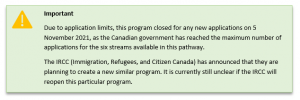The pathway leading from temporary residency to permanent residency is a pathway for temporary residents who are currently working in Canada.
The program enables the resident and their families to obtain permanent residency if they meet one of the following two criteria:
- You have gained work experience in Canada in an essential occupation or in the health care sector
OR
- You have recently completed your studies at a post-secondary institution in Canada
The program is part of Canada’s intention to create several new pathways to permanent residency for certain temporary residents post pandemic.

Temporary Resident to Permanent Resident Pathway Streams
| 3 General streams | 3 French-speaking streams |
| Workers in Canada: health care | French-speaking workers in Canada: health care |
| Workers in Canada: essential, non-health care | French-speaking workers in Canada: essential, non-health care |
| Recent international graduates from a Canadian institution | French-speaking recent international graduates from a Canadian institution |
Who can apply for the Temporary Resident to Permanent Resident (TR to PR) Pathway Streams?
To be eligible for the health care and non-health care essential streams, you must:
- be in Canada
- have valid status in Canada
- plan to live outside of Quebec
- meet or exceed the language requirements
- be currently employed
- have eligible work experience
- not be a refugee claimant in Canada
To be eligible for the recent international graduate streams, you must also have recently graduated from a designated learning institution in Canada with an eligible credential.
Temporary Resident to Permanent Resident (TR to PR) Pathway Canada
Graduation requirements
To be eligible for the TR to PR recent international graduate pathway, you must also have been authorized to study for the duration of your studies and graduated on or after January 1, 2017, from an eligible program at a designated learning institution (DLI). Your school must also offer post-graduation work permits (PWGPs). You do not need to have a PGWP in order to apply.
Eligible programs
To apply through the recent international graduate stream, you must have graduated with one of the following:
- a degree (Associate, Bachelor’s, Master’s or Doctorate) with a program length of at least 8 months
- a degree, diploma, certificate or attestation leading to a job from the list of eligible trade occupations
- a diploma, certificate or attestation for a program that was at least 2 years (16 months) in length
- two or more diplomas, certificates or attestations where each program was at least 8 months in length
- a diploma of vocational studies (DVS) or an attestation of vocational specialization (AVS) where each program was at least 1,800 hours in length
- two or more DVS or AVS where each program was at least 900 hours in length
- When combining 1 AVS with 1 DVS, the length of the AVS program may be less than 900 hours if the combined length is at least 1,800 hours.
Eligible trade occupations for the recent international graduate streams
| NOC Occupation |
| 7201 Contractors and supervisors, machining, metal forming, shaping and erecting trades and related occupations
7202 Contractors and supervisors, electrical trades and telecommunications occupations 7203 Contractors and supervisors, pipefitting trades 7204 Contractors and supervisors, carpentry trades 7205 Contractors and supervisors, other construction trades, installers, repairers and servicers 7231 Machinists and machining and tooling inspectors 7232 Tool and die makers 7233 Sheet metal workers 7234 Boilermakers 7235 Structural metal and platework fabricators and fitters 7236 Ironworkers 7237 Welders and related machine operators 7241 Electricians (except industrial and power system) 7242 Industrial electricians 7243 Power system electricians 7244 Electrical power line and cable workers 7245 Telecommunications line and cable workers 7246 Telecommunications installation and repair workers 7247 Cable television service and maintenance technicians 7251 Plumbers 7252 Steamfitters, pipefitters and sprinkler system installers 7253 Gas fitters 7271 Carpenters 7272 Cabinetmakers 7281 Bricklayers 7282 Concrete finishers 7283 Tilesetters 7284 Plasterers, drywall installers and finishers and lathers 7291 Roofers and shinglers 7292 Glaziers 7293 Insulators 7294 Painters and decorators (except interior decorators) 7295 Floor covering installers 7301 Contractors and supervisors, mechanic trades 7302 Contractors and supervisors, heavy equipment operator crews 7303 Supervisors, printing and related occupations 7304 Supervisors, railway transport operations 7305 Supervisors, motor transport and other ground transit operators 7311 Construction millwrights and industrial mechanics 7312 Heavy-duty equipment mechanics 7313 Heating, refrigeration and air conditioning mechanics 7314 Railway carmen/women 7315 Aircraft mechanics and aircraft inspectors 7316 Machine fitters 7318 Elevator constructors and mechanics 7321 Automotive service technicians, truck and bus mechanics and mechanical repairers 7322 Motor vehicle body repairers 7331 Oil and solid fuel heating mechanics 7332 Appliance servicers and repairers 7333 Electrical mechanics 7334 Motorcycle, all-terrain vehicle and other related mechanics 7335 Other small engine and small equipment repairers 7361 Railway and yard locomotive engineers 7362 Railway conductors and brakemen/women 7371 Crane operators 7372 Drillers and blasters – surface mining, quarrying and construction 7373 Water well drillers 7381 Printing press operators 7384 Other trades and related occupations, n.e.c. 8211 Supervisors, logging and forestry 8221 Supervisors, mining and quarrying 8222 Contractors and supervisors, oil and gas drilling and services 8231 Underground production and development miners 8232 Oil and gas well drillers, servicers, testers and related workers 8241 Logging machinery operators 8252 Agricultural service contractors, farm supervisors and specialized livestock workers 8255 Contractors and supervisors, landscaping, grounds maintenance and horticulture services 8261 Fishing masters and officers 8262 Fishermen/women 9211Supervisors, mineral and metal processing 9212 Supervisors, petroleum, gas and chemical processing and utilities 9213 Supervisors, food and beverage processing 9214 Supervisors, plastic and rubber products manufacturing 9215 Supervisors, forest products processing 9217 Supervisors, textile, fabric, fur and leather products processing and manufacturing 9221 Supervisors, motor vehicle assembling 9222 Supervisors, electronics manufacturing 9223 Supervisors, electrical products manufacturing 9224 Supervisors, furniture and fixtures manufacturing 9226 Supervisors, other mechanical and metal products manufacturing 9227 Supervisors, other products manufacturing and assembly 9231 Central control and process operators, mineral and metal processing 9232 Central control and process operators, petroleum, gas and chemical processing 9235 Pulping, papermaking and coating control operators 9241 Power engineers and power systems operators 9243 Water and waste treatment plant operators 6321 Chefs 6322 Cooks 6331 Butchers, meat cutters and fishmongers – retail and wholesale 6332 Bakers |
Work experience
To be eligible for any of the six streams in the TR to PR pathway, you need 1 year of work experience (at least 1,560 hours) in the past 3 years. Unlike your current employment, which can be in any job, your experience needs to be in one or more eligible occupations.
Your work experience must include:
- most of the main duties and all the essential duties listed in your National Occupational Classification (NOC)
- the activities listed in the lead statement of your NOC
You can see which duties are involved by searching your job title on the NOC web page.
To calculate your hours of work experience, count all paid hours worked in part-time and full-time jobs. The hours must be in one or more eligible occupations and be over a period of at least 12 months. Self-employment is not considered part of paid working hours, however, if you worked as a medical doctor in a fee-for-service arrangement with a health authority, these paid hours still count in the calculation.
Eligible occupations for healthcare and essential workers
In Canada, occupations are classified by the National Occupational Classification (NOC) code. Each NOC code has a full list of duties for each occupation.
| NOC Occupation |
| 3011 Nursing co-ordinators and supervisors 3012 Registered nurses and registered psychiatric nurses 3111 Specialist physicians 3112 General practitioners and family physicians 3113 Dentists 3121 Optometrists 3122 Chiropractors 3124 Allied primary health practitioners 3125 Other professional occupations in health diagnosing and treating 3131 Pharmacists 3132 Dietitians and nutritionists 3141 Audiologists and speech-language pathologists 3142 Physiotherapists 3143 Occupational therapists 3144 Other professional occupations in therapy and assessment 3211 Medical laboratory technologists 3212 Medical laboratory technicians and pathologists’ assistants 3214 Respiratory therapists, clinical perfusionists and cardiopulmonary technologists 3215 Medical radiation technologists 3216 Medical sonographers 3217 Cardiology technologists and electrophysiological diagnostic technologists, n.e.c. 3219 Other medical technologists and technicians (except dental health) 3221 Denturists 3222 Dental hygienists and dental therapists 3223 Dental technologists, technicians and laboratory assistants 3231 Opticians 3232 Practitioners of natural healing 3233 Licensed practical nurses 3234 Paramedical occupations 3236 Massage therapists 3237 Other technical occupations in therapy and assessment 3411 Dental assistants 3413 Nurse aides, orderlies and patient service associates 3414 Other assisting occupations in support of health services 4151 Psychologists 4152 Social workers 4153 Family, marriage and other related counsellors 4165 Health policy researchers, consultants and program officers 4212 Social and community service workers 4412 Home support workers, housekeepers and related occupations |
Need help with deciding what visa is right for you and your family?






Top in demand jobs in Canada for immigrants
Temporary Resident to Permanent Resident (TR to PR) Pathway Canada
How to Immigrate to Canada
Moving to Canada from the US
New Alberta Express Entry Stream – Accelerated Tech Pathway